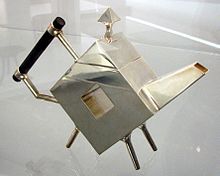Christopher Dresser
Christopher Dresser (born July 4, 1834 in Glasgow , † November 24, 1904 in Mulhouse ) was a British designer . Dresser is widely recognized as the UK's first professional independent industrial designer. Today he is considered a pioneer of Art Nouveau alongside William Morris .
Life
In 1847 Dresser went to the London Government School of Design in Somerset House to study botany and drawing. His designs were heavily influenced by the aesthetics of the Arts and Crafts Movement . In his early phase from 1850 to 1876 he tried to find machine-suitable shapes for his designs. While the early work was more ornamental and historical, the late work was very puristic. From this transformed style, Dresser came to his minimalist objects. His designs anticipated the functionalism of the 1920s very much. In 1870 his name became a brand. He worked with all materials - mainly metal - for more than 50 manufacturers. From 1880 to around 1895 he was a senior designer at James Couper & Sons , when George Walton replaced him in this role.
It was long forgotten when Nikolaus Pevsner rediscovered it in 1937 through an article in the Architectural Record magazine . Some of his designs were reissued, for example in 1993 the "conical sugar bowl" by Alessi .
literature
- Harry Lyons: Christopher Dresser: The People's Designer - 1834-1904 , Antique Collectors' Club Ltd., Woodbridge, Suffolk, 2005, ISBN 9781851494552 , p. 398
- Widar Halén: Christopher Dresser: a pioneer of modern design , Phaidon Press, London 1994, ISBN 9780714829524 , p. 208.
- Sabine Thümmler: Always Modern: Design classics from 1825 to 1985 from the holdings of the Kunstgewerbemuseum Berlin , Sandstein Verlag, Berlin 2017, ISBN 9783954983605 , p. 22.
Web links
Individual evidence
- ↑ Ildikó Kálosi, Diána Radványi: Tiffany & Gallé Art Nouveau Glass . Ed .: Gabriella Balla. Museum of Applied Arts ( Hungarian Museum of Applied Arts ), Budapest 2007, ISBN 978-963-9738-03-4 , p. 133 .
| personal data | |
|---|---|
| SURNAME | Dresser, Christopher |
| BRIEF DESCRIPTION | British designer |
| DATE OF BIRTH | 4th July 1834 |
| PLACE OF BIRTH | Glasgow |
| DATE OF DEATH | November 24, 1904 |
| Place of death | Mulhouse |

